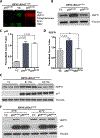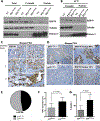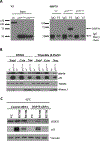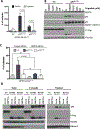Mutant p53R175H promotes cancer initiation in the pancreas by stabilizing HSP70
- PMID: 30946870
- PMCID: PMC9753970
- DOI: 10.1016/j.canlet.2019.03.047
Mutant p53R175H promotes cancer initiation in the pancreas by stabilizing HSP70
Abstract
Pancreatic cancer remains a highly lethal malignancy. We have recently shown that simultaneous expression of Kras and mutant Tp53R175H promotes invasive ductal adenocarcinoma from pancreatic ductal cells. We hypothesized specific mutations in TP53 have divergent mechanisms of transforming ductal cells. In order to understand the role of mutant TP53 in transforming pancreatic ductal cells, we used a lentiviral system to express mutant TP53R175H and TP53R273H, two of the most frequently mutated TP53 alleles in pancreatic cancer patients, in immortalized, but not transformed, pancreatic ductal epithelial cells carrying a KRAS mutation (HPNE:KRASG12D). Mutant TP53 expression enhanced colony formation and an RPPA assay results revealed TP53R175H uniquely induced HSP70 expression in HPNE:KRASG12D cells. In the context of TP53R175H expression; we observed nuclear localization of HSP70. We performed immunoprecipitation experiments to show mutant p53R175H binds to HSP70. We also provide evidence mutant p53R175H is important for HSP70 stability and, more importantly, HSP70 is required for mutant p53 stability. These data are critical in the context of events leading to cellular transformation in the pancreas.
Keywords: Pancreatic cancer; Proteomics.
Copyright © 2019 Elsevier B.V. All rights reserved.
Conflict of interest statement
Competing Interests
The authors have no competing financial interests to disclose.
Figures






Similar articles
-
Mutant p53R270H drives altered metabolism and increased invasion in pancreatic ductal adenocarcinoma.JCI Insight. 2018 Jan 25;3(2):e97422. doi: 10.1172/jci.insight.97422. eCollection 2018 Jan 25. JCI Insight. 2018. PMID: 29367463 Free PMC article.
-
p53 mutations cooperate with oncogenic Kras to promote adenocarcinoma from pancreatic ductal cells.Oncogene. 2016 Aug 11;35(32):4282-8. doi: 10.1038/onc.2015.441. Epub 2015 Nov 23. Oncogene. 2016. PMID: 26592447
-
The Mutant p53-Driven Secretome Has Oncogenic Functions in Pancreatic Ductal Adenocarcinoma Cells.Biomolecules. 2020 Jun 9;10(6):884. doi: 10.3390/biom10060884. Biomolecules. 2020. PMID: 32526853 Free PMC article.
-
The Roles of Frequently Mutated Genes of Pancreatic Cancer in Regulation of Tumor Microenvironment.Technol Cancer Res Treat. 2020 Jan-Dec;19:1533033820920969. doi: 10.1177/1533033820920969. Technol Cancer Res Treat. 2020. PMID: 32372692 Free PMC article. Review.
-
Effects of TP53 Mutations and miRs on Immune Responses in the Tumor Microenvironment Important in Pancreatic Cancer Progression.Cells. 2022 Jul 9;11(14):2155. doi: 10.3390/cells11142155. Cells. 2022. PMID: 35883598 Free PMC article. Review.
Cited by
-
Small-Molecule MMRi62 Induces Ferroptosis and Inhibits Metastasis in Pancreatic Cancer via Degradation of Ferritin Heavy Chain and Mutant p53.Mol Cancer Ther. 2022 Apr 1;21(4):535-545. doi: 10.1158/1535-7163.MCT-21-0728. Mol Cancer Ther. 2022. PMID: 35131878 Free PMC article.
-
The Function of the Mutant p53-R175H in Cancer.Cancers (Basel). 2021 Aug 13;13(16):4088. doi: 10.3390/cancers13164088. Cancers (Basel). 2021. PMID: 34439241 Free PMC article. Review.
-
SLMP53-2 Restores Wild-Type-Like Function to Mutant p53 through Hsp70: Promising Activity in Hepatocellular Carcinoma.Cancers (Basel). 2019 Aug 10;11(8):1151. doi: 10.3390/cancers11081151. Cancers (Basel). 2019. PMID: 31405179 Free PMC article.
-
EZH2 inhibition confers PIK3CA-driven lung tumors enhanced sensitivity to PI3K inhibition.Cancer Lett. 2022 Jan 1;524:151-160. doi: 10.1016/j.canlet.2021.10.010. Epub 2021 Oct 13. Cancer Lett. 2022. PMID: 34655667 Free PMC article.
-
The EGFR-HSF1 axis accelerates the tumorigenesis of pancreatic cancer.J Exp Clin Cancer Res. 2021 Jan 9;40(1):25. doi: 10.1186/s13046-020-01823-4. J Exp Clin Cancer Res. 2021. PMID: 33422093 Free PMC article.
References
-
- Siegel RL, Miller KD, and Jemal A, Cancer Statistics, 2017. CA Cancer J Clin, 2017. 67(1): p. 7–30. - PubMed
-
- Sidaway P, Pancreatic cancer: TCGA data reveal a highly heterogeneous disease. Nat Rev Clin Oncol, 2017. 14(11): p. 648. - PubMed
-
- Bailey P, et al., Genomic analyses identify molecular subtypes of pancreatic cancer. Nature, 2016. 531(7592): p. 47–52. - PubMed
Publication types
MeSH terms
Substances
Grants and funding
LinkOut - more resources
Full Text Sources
Medical
Research Materials
Miscellaneous

